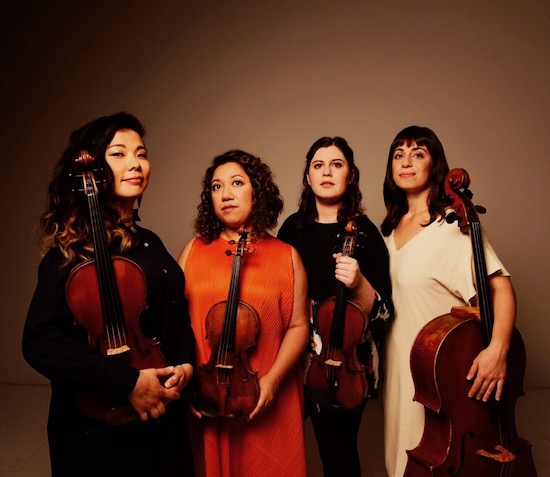Aizuri Quartet makes bracing impact with envelope-pushing Kravis program

Photo: Shervin Lainez
The most conventional thing about Monday’s concert by the Aizuri Quartet was the reassuring presence of Haydn on the program.
Beyond that, the cello got slapped like a bongo, they performed a rarely heard work of Sibelius and the melancholy tones of Armenian folk songs wafted from the stage.
The quartet, founded in 2012, has a reputation for imaginative programming, and that certainly proved to be the case in their performance at the Kravis Center’s Rinker Playhouse in West Palm Beach.
The Aizuri Quartet—which takes its name from blue Japanese woodblock prints—opened with Carrot Revolution by the young California composer Gabriella Smith, who wrote it for the quartet in 2015.
Cellist Karen Ouzounian was required to beat out rhythms on her instrument with the palm of her hand. The other musicians played repeated, strongly marked figures, and first violinist Emma Frucht produced swooping tones that sounded nothing like a violin.
They played all this with gusto, and at first it appeared the work would simply manage the dubious accomplishment of turning a string quartet into a percussion section. But other things happened. Melodies rose out of the rhythmic undergirding. In particular, violist Ayane Kozasa produced dark tones, joined by the violins, that had a bardic quality, like old-time folk melodies passed from generation to generation. The work sounded very American in its mix of folk, rock and classical sensibilities.
When the musicians turned to Haydn’s String Quartet in B minor, Op. 64, no. 2, they didn’t work overtime creating the kind of surface gloss that marks many other leading quartets (although as they showed later, they could achieve that sort of united corporate sound when they wanted to). Rather than going for the texture of a single 16-stringed instrument, they played in a manner that never let you forget there were four individual musicians on stage, and the performance was better for it.
They played the opening Allegro spiritoso with dramatic flair, with portentous pauses and theatrical attacks, as when the minor key asserted itself in the opening moments. In the Classical era, string quartets were as often called violin quartets, a name that suggested the prominence of the first violin part. In this work that was certainly the case, and first violinist Frucht handled her concerto-like solo, with its runs and high-flying melodies, with style and polish.
In the Adagio, expressively played accompaniments by the cellist, violist and second violin took much of the attention. The Minuet was a fiery episode with a dramatic crescendo, and the finale crackled with cool energy, with an extra touch of Magyar zing to the performance.
After intermission, the Aizuri Quartet performed five Armenian folk songs transcribed by the priest and musicologist Komitas Vartabed, and arranged for string quartet by Sergei Aslamazian.
Melancholy, joyful, doleful and energetic, the melodies sounded faintly Hungarian. In this string quartet version, with its complex harmonies and effective arrangements, they resembled the polished, concert hall “gypsy” music turned out by 19th European composers. The musicians played them with feeling but without excessive or exaggerated emotion—straight, with respect and lot of earthy vigor.
For those familiar with Sibelius’s symphonic works, the String Quartet “Voces intimae” presents a different side of the composer. As the title suggests, it’s more inward looking, with few of the craggy, extroverted passages that mark his symphonies and Violin Concerto.
The work opened with a serious and expressive dialogue between first violin and cello. It proceeded through episodes of restlessness and darkness, creating a twilight mood that would be the dominant tone of the work.
In this work, the quartet played with the sort of tight unity they didn’t always show in the Haydn. The Vivace was fleet and crisp. The central Adagio, the heart of the piece, was marked by playing of incredible softness and richness, with the members playing grave pianissimo chords as if breathing together, with a perfect balance among instruments.
The Allegretto turned into a drama of its own, with the musicians playing a big, bold melody at the opening that would return as a wispy, ghostly shadow. The concluding Allegro was a tour-de-force of fiery brilliance, as the musicians played the machine-gun-like rush of notes with extreme lightness, speed and accuracy in an impressive display of sheer virtuosity.
Posted in Performances
Leave a Comment
Tue Dec 10, 2019
at 11:35 am
No Comments





